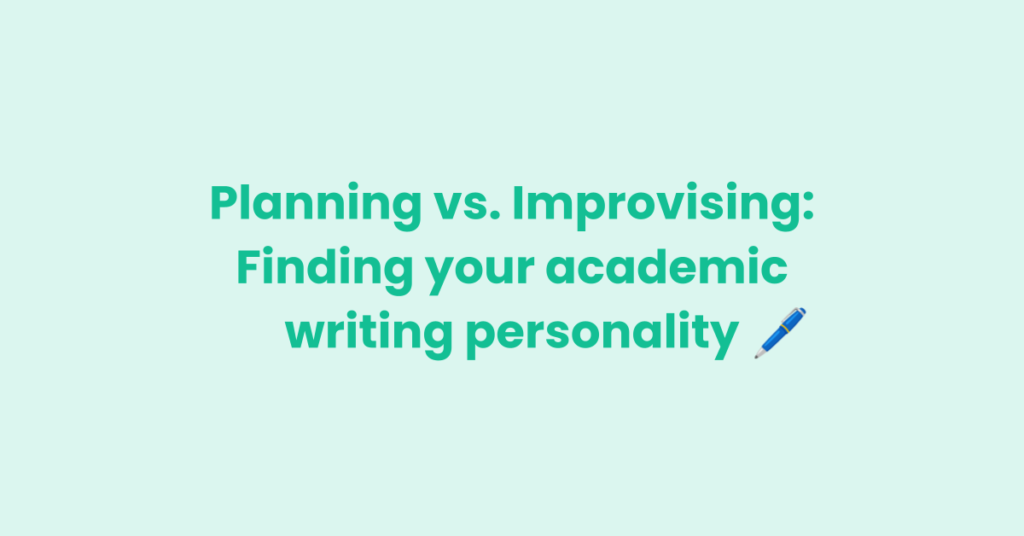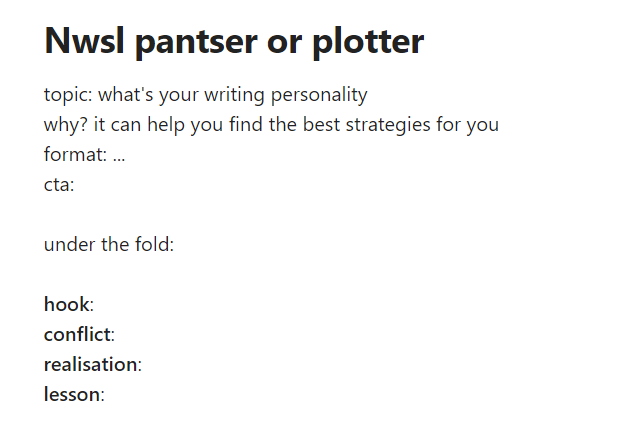
A couple of weeks ago I wrote how planning can make writing easier. But what if you’re not much of a planner?
In writing, just like in life, there’s different types of people. In novel writing, this division is called pantsers vs plotters.
As this Medium article puts it:
Plotters [planners] are plot focused — they outline their entire novel, often scene by scene, before beginning to write it. Their outline is a skeleton of their novel, letting them see the big picture and keeping their writing on track.
Pantsers [improvisers], on the other hand, “fly by the seat of their pants” — they dream up a novel’s concept and characters, then just start writing, often with no (or little) idea of where the story is headed. This allows their story to develop organically.
Both strategies are equally valid. In fact, there’s many wildly successful authors that fall on either side of the spectrum of plotting (such as J.K. Rowling) versus pantsing (like Stephen King).
To plot or to pants in academic writing?
| Plotters (planners) | Panters (improvisers) | |
|---|---|---|
| Pros | – Can visualise the big picture – Planning results in a coherent paper – Quick writers: outline tells them what to write next | – Easy to get words on paper – Can let creativity flow more freely, i.e. more flexibility to incorporate new ideas about data as they pop up |
| Cons | – Can spend too much time planning; use plotting as a way to procrastinate on actually writing – May struggle with incorporating new ideas, have to change entire outline | – Slower writers – Go off on tangents, overall papers can be less coherent – Easy to get stuck (writer’s block) because it’s unclear what to write next |
So how does that translate to academic writing?
Novels and peer-reviewed journal articles are both complex documents. But, while you can get away with dreaming up a story in novel writing (although you still need to adhere to a certain logic), academic papers are much more rigid.
In a novel, you can change your mind and decide to kill of the main character’s love interest. In science, you can’t change your findings. They are what they are. Given this rigidity in academic writing, you’d expect that plotting is better for journal articles. But is that really true?
Can you write a journal article without much planning?
The answer is, yes, absolutely!
How do I know? Because I am one of those pantsers.
Although nowadays I’m more of a half-pantser. Let me explain.
My brain prefers to follow it’s own chaotic trains of thought. It does not like to have structure superimposed, like having to outline a paper in a certain way. For example, in preparing this newsletter I made a rather half-assed attempt at outlining:

I’ve always preferred to write like this. I simply pick up my laptop and start typing. It just works
better for me. But I’ve learned some things along the way. Whenever I write, I need to follow two rules:
Rule number 1:
I need to know why I’m writing the thing I’m writing. What goal am I trying to achieve? Without a goal in mind, my writing quickly dissolves into an incomprehensible word salad. This means that for bigger documents, I do need an outline, because every section and
paragraph needs to have a goal.
Rule number 2:
I have to edit the structure of whatever it is I wrote thoroughly. By structurally editing, I make
sure that sentences that belong together end up near each other, and not on opposite sides of the document.
Find a strategy that suits your writing personality
Over time, I’ve become more of a plotter. But only as much as I have to. As soon as I can, I create opportunities for myself to write freely. I really don’t like spending more time planning than I have to. As long as I have a goal in mind and edit properly, pantsing gets me pretty far.
Understanding your writing preferences can make writing a lot more enjoyable, and help you recognise potential pitfalls.
So how do you know what strategy works best for you? Perhaps you already know what your writing personality is. But if you’re not sure, why not test it out? For example, you can approach the next two things you need to write using both strategies, whether that’s an email, part of a paper, or something else.
- Write one item as plotter: make a proper outline before you start writing.
- Write the other item as a pantser: simply start writing.
What worked better for you? What did you find easier? And what got you the best results? Let me know what you find.
[mailerlite_form form_id=8]
